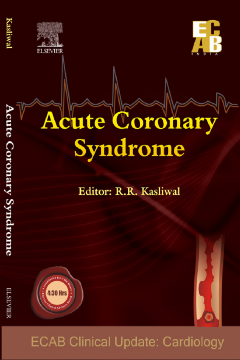
Additional Information
Book Details
Abstract
Acute coronary syndrome (ACS) is the term for the clinical signs and symptoms of myocardial ischemia: unstable angina, non–ST-segment elevation myocardial infarction (NSTEMI), and ST-segment elevation myocardial infarction (STEMI). Unstable angina and NSTEMI normally result from a partially or intermittently occluded coronary artery, whereas STEMI results from a fully occluded coronary artery.
The patients present with a wide arena of signs and symptoms like chest pain, nausea/vomiting, exertional pain, palpitation, shortness of breath, fatigue, etc. Angina, or chest pain, continues to be recognized as the classic symptom of ACS. In unstable angina, chest pain normally occurs either at rest or with exertion and results in limited activity. Chest pain associated with NSTEMI is usually longer in duration and more severe than chest pain associated with unstable angina.
The diagnosis of ACS is based on triad of clinical presentation, electrocardiography and cardiac biomarkers. Electrocardiography is the most important initial diagnostic procedure when doctors suspect an acute coronary syndrome. Findings on a 12-lead ECG help the practitioner to differentiate between myocardial ischemia, injury, and infarction, locate the affected area and assess related conduction abnormalities. But at the same front, the definition of unstable angina, NSTEMI and STEMI is based on the levels of cardiac biomarkers too.
Acute coronary syndromes are medical emergencies that need prompt action. Half of deaths due to a heart attack occur in the first 3–4 hours after symptoms begin. The sooner treatment begins, the better the chances of survival. Anyone having symptoms that might indicate an acute coronary syndrome should obtain prompt medical attention. Management of ACS involves a spectrum of interventions. It encompasses cardiac monitoring, thrombolysis, antiplatelet therapy, anticoagulant therapy, reperfusion therapy and invasive investigation and revascularization therapy. Reperfusion therapy (percutaneous coronary intervention) mainly holds for the ST-elevation myocardial infarction.
Prognosis of the ACS patients depends on the post-myocardial risk stratification. The main highlights of risk stratification are risk stratification scores, assessment of cardiac function and stress testing, and management.
